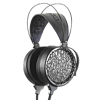 37
37
Dan Clark Audio CORINA Electrostatic Headphones Review
(37 Comments) »Value and Conclusion
- The Dan Clark Audio CORINA is a recently released set of over-ear, open back electrostatic headphones which costs $4499.99 from the Dan Clark Audio web shop as well as authorized dealers such as Headamp as of the date of this review. The cost increases should you go with longer cables, going up to $4799.99 with a 5 m cable.
- Extremely innovative engineering
- The best vocals reproduction in any headphones I've listened to
- Extremely smooth, natural presentation
- Highly detailed while being non-fatiguing
- Excellent instrument separation
- Precise imaging even in complex tracks
- Accurate reproduction in the mids lends favorably for music mastering
- Works well as an all-rounder set for general media consumption
- Wide and tall soundstage
- Fantastic channel matching, including custom matched ear pads
- Highly comfortable to wear for long periods of time
- Integrated dust shields protect the drivers in use
- Good quality cable which can be swapped out for different lengths
- Excellent customer support
- Flagship costs, albeit in this case it does feel justified
- Bass response could be more impactful, albeit on par with most e-stats
I am glad that I have already reviewed some electrostatic headphones before, else adding in more context about how they work and are different from dynamic/planar magnetic headphones would have made this lengthy review even longer. I do think people need to be paying more attention to the e-stat headphone world because we are seeing some fascinating developments here in terms of product design and engineering. The Dan Clark Audio CORINA is a great example of this with a few neat innovations employed. Some, such as the matched ear pads, might be dismissed by a few as an unnecessary or impractical gimmick, but I would rather companies spend money on this than, say, a leather-wrapped box that isn't used after the headphones are removed. Besides, when we talk about products that cost $4500, there are expectations to see features not found in less expensive headphones. With DCA already showcasing driver matching throughout its product line up, this was just the next logical step up for what is now its most expensive product to date.
But no, what interested me most with the CORINA was Dan Clark's vision of how e-stats should sound. I have not heard the VOCE admittedly, but I know what most other e-stats sound like. There are maybe five that I can see myself considering to buy with the vast majority having "special" tonalities that result in poor timbre and specific use cases. The CORINA bucks this trend by not only being the best overall sounding e-stat I've had my ears on, but arguably also the best overall set of headphones period! The end result is a relatively safe tonality backed by good technicalities too, especially when it comes to detail retrieval and vocals reproduction. Then we get to DCA's patent-pending AMTS implementation—well worth reading more about this on page four—that makes this a very smooth sound too without any harsh peaks or dips. The mids are the star of the show here for me but there's still something special about a well-controlled e-stat treble response in terms of how natural everything sounds. This is especially valid with string instruments and piano keys and makes the CORINA a good set for classical music too, although I did add a single EQ filter to provide some more mid-treble energy for my liking.
I mentioned before how the DCA CORINA is the only set to date that has made me appreciate vocals-only tracks enough to add them to my playlist that is otherwise dominated by jazz and orchestral music. This alone makes it special for me and why I thought long and hard about whether or not to give it our top award. Yes, there are the usual e-stat challenges in mind wherein you would make the most of the set when paired with a powerful amplifier capable of providing lots of volts. The $400 Topping EHA5 gets you most of the way though and the fairly neutral tonality of the CORINA combined with drivers that aren't the hardest to drive mean you can perhaps get away with it if your budget was limited. But if you have decided to go all aboard the e-stat train with an excellent, albeit highly expensive amplifier such as my Headamp BHSE, then the CORINA is a logical move to get something that does it all—quite well too! Then there's the nice bonus of replacement cable lengths as well as integrated dust shields which means you do not need to baby the CORINA as much as other e-stats. Given that it's already taken up the mantle of my best sounding set of headphones overall, I suppose it's only fair that I do say it is this editor's choice at least.


But no, what interested me most with the CORINA was Dan Clark's vision of how e-stats should sound. I have not heard the VOCE admittedly, but I know what most other e-stats sound like. There are maybe five that I can see myself considering to buy with the vast majority having "special" tonalities that result in poor timbre and specific use cases. The CORINA bucks this trend by not only being the best overall sounding e-stat I've had my ears on, but arguably also the best overall set of headphones period! The end result is a relatively safe tonality backed by good technicalities too, especially when it comes to detail retrieval and vocals reproduction. Then we get to DCA's patent-pending AMTS implementation—well worth reading more about this on page four—that makes this a very smooth sound too without any harsh peaks or dips. The mids are the star of the show here for me but there's still something special about a well-controlled e-stat treble response in terms of how natural everything sounds. This is especially valid with string instruments and piano keys and makes the CORINA a good set for classical music too, although I did add a single EQ filter to provide some more mid-treble energy for my liking.
I mentioned before how the DCA CORINA is the only set to date that has made me appreciate vocals-only tracks enough to add them to my playlist that is otherwise dominated by jazz and orchestral music. This alone makes it special for me and why I thought long and hard about whether or not to give it our top award. Yes, there are the usual e-stat challenges in mind wherein you would make the most of the set when paired with a powerful amplifier capable of providing lots of volts. The $400 Topping EHA5 gets you most of the way though and the fairly neutral tonality of the CORINA combined with drivers that aren't the hardest to drive mean you can perhaps get away with it if your budget was limited. But if you have decided to go all aboard the e-stat train with an excellent, albeit highly expensive amplifier such as my Headamp BHSE, then the CORINA is a logical move to get something that does it all—quite well too! Then there's the nice bonus of replacement cable lengths as well as integrated dust shields which means you do not need to baby the CORINA as much as other e-stats. Given that it's already taken up the mantle of my best sounding set of headphones overall, I suppose it's only fair that I do say it is this editor's choice at least.


Jul 14th, 2025 16:09 CDT
change timezone
Latest GPU Drivers
New Forum Posts
- Share your AIDA 64 cache and memory benchmark here (3099)
- Frametime spikes and stuttering after switching to AMD CPU? (573)
- AAF Optimus Modded Driver For Windows 10 & Windows 11 - Only for Realtek HDAUDIO Chips (578)
- i7 2860QM how to raise power limit? (21)
- AMD 7Ghz? This keeps popping up on my feeds! (6)
- Stupid things one has done with hardware (49)
- No offense, here are some things that bother me about your understanding of fans. (111)
- Choosing the right motherboard (5)
- Best motherboards for XP gaming (151)
- Which CPU to Choose for a 7900 XT? Ryzen 7 7700 or Ryzen 5 9600X? (43)
Popular Reviews
- Lexar NM1090 Pro 4 TB Review
- Our Visit to the Hunter Super Computer
- MSI GeForce RTX 5060 Gaming OC Review
- Fractal Design Epoch RGB TG Review
- NVIDIA GeForce RTX 5050 8 GB Review
- Corsair FRAME 5000D RS Review
- Sapphire Radeon RX 9060 XT Pulse OC 16 GB Review - An Excellent Choice
- Chieftec Iceberg 360 Review
- AMD Ryzen 7 9800X3D Review - The Best Gaming Processor
- Upcoming Hardware Launches 2025 (Updated May 2025)
TPU on YouTube
Controversial News Posts
- Intel's Core Ultra 7 265K and 265KF CPUs Dip Below $250 (288)
- Some Intel Nova Lake CPUs Rumored to Challenge AMD's 3D V-Cache in Desktop Gaming (140)
- AMD Radeon RX 9070 XT Gains 9% Performance at 1440p with Latest Driver, Beats RTX 5070 Ti (131)
- NVIDIA Launches GeForce RTX 5050 for Desktops and Laptops, Starts at $249 (122)
- NVIDIA GeForce RTX 5080 SUPER Could Feature 24 GB Memory, Increased Power Limits (115)
- Microsoft Partners with AMD for Next-gen Xbox Hardware (105)
- Intel "Nova Lake‑S" Series: Seven SKUs, Up to 52 Cores and 150 W TDP (100)
- NVIDIA DLSS Transformer Cuts VRAM Usage by 20% (97)